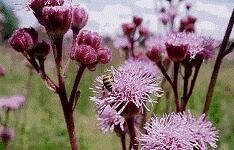 |
 |
 |

 Buy outdoor gear online at WWW-KREATURE.CO.ZA |
||
Don't throw me around ...
Pompom
The bad group are those trees and plants which have been imported into South Africa and which simply do not know how to behave in our environment. Also known as aliens.
Check out the Department of Agriculture list of aliens.
Link: Department of Agriculture
 |
Pompom weed, (Campuloclinium Macrocephalum).
This is an invader, one which has been lurking silently and prettily for some time. It?’s a tall herb with conspicuous, light purple to pink flowerheads growing in large numbers along roadsides and in grasslands. One reaction is to cut these beautiful flowers for home. When the flowers die, they are thrown away ?– but they are not gone ?– the seeds spread easily and this is one of the reasons why the plant has become so widespread. Beware ?– attractive as its flowers may be, this alien plant spells trouble for the environment.
It belongs to the family Asteraceae (the daisy family) and is closely related to weeds. It is a native of Brazil but is also known in Paraguay. The genius Campuloclinium has a total of 20 species, all of which are indigenous to the tropical Americas. The pompon weed is a herb with a perennial rootstock and several erect stems, growing each spring from a rhizome (modified underground stem). The upright stems may be green or purplish, and both the stems and leaves are covered with dense, bristly hairs. In summer, from December to March, numerous pink to light purple flowerheads are visible at the tip of the stems. Each flowerhead, about 25mm in diameter, consists of hundreds of tiny purple, strap-shaped florets surrounded by purple bracts. The florets mature to produce tiny, brown, one seeded fruits, about 5mm long, with tufts of bristles that promote dispersal by wind. Pompon weeds reproduce both through seeds and vegetatively. Vegetatively reproduction refers to the plant?’s ability to produce new plants from its underground rhizomes. A rhizome is a modified, nutrient filled underground stem that has numerous nodes along its length. Each of these nodes can give rise to a new plant. It has been reported that the roots secrete a chemical into the soil which prevents indigenous plants from germinating in its vicinity. Because it is unpalatable, livestock do not eat it. As a result, it gradually replaces the more palatable plant species and thus tends to become one of the only surviving plant species in overgrazed areas.





 |
 |
 |

